'Don't wash them too regularly': One pair of jeans is all we need – here's why
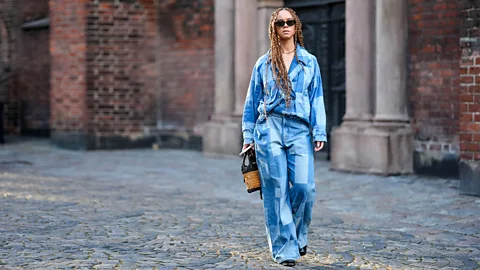 Getty Images
Getty ImagesFrom skinny to barrel and ultra-high to low-slung, jeans trends are ever changing – so how can we choose the perfect pair for us, and maintain them properly?
Few items of clothing are both as iconic and ubiquitous as a pair of jeans. With era-defining silhouettes that capture cultural moments in time, jeans are a wardrobe staple. But they're also one of fashion's most polluting categories, prone to high trend cycles and – as a result – hanging in our wardrobes unworn.
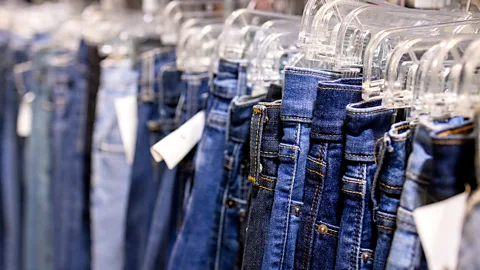 Getty Images
Getty ImagesTake this season's trends. Last year, Vogue reported that skinny jeans were making a comeback, only to call it a fleeting moment 12 months later, and now they’re back again – with the Princess of Wales as poster girl. "Slim" silhouettes are in, too, alongside belted and baggy, and – the shape of the season – barrel-leg jeans: a fitted waist that leads into a slightly voluminous leg and then tapers at the ankle. With as many fits and trends as there are body shapes and tastes, how do we invest in the perfect pair?
Personal stylist Alexandra Fullerton says that the barrel-leg silhouette works with most body shapes. "They are pleasingly loose across the legs and sit around the true waist, therefore they should have a lasting place in one's wardrobe," she tells the BBC. "They are just a baby step away from the boyfriend jean, which is now a perma-trend."
But Fullerton stresses that buying a pair of jeans should be a marathon, not a sprint, and advises her clients to build a shortlist of styles based on research. What washes do you like? Which brands do you admire? Who in the public eye has a similar body shape that you can take tips from?
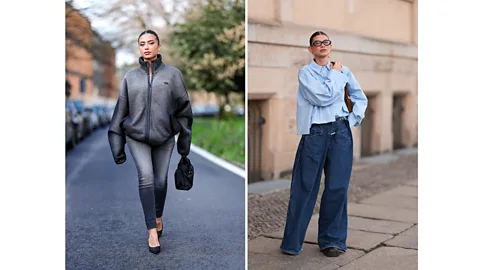 Getty Images
Getty Images"Putting in some work – that's a couple of hours in a real-life store with a well-lit fitting room and ideally a friend – will ensure the best purchase," says Fullerton. "Department stores with dedicated denim shops are the best place to start. Whatever your budget, jeans should be an investment so shop with longevity, rather than trends, in mind."
Fullerton cautions that extremes – skinny and super-wide or ultra-high and low-rises – are more prone to cycling in and out of fashion. "Better to choose a less severe silhouette that will outlast any fad, like a straight leg or modestly wide jean with a mid-to-high rise which will be classic for years ahead," she advises. "Mid-blue is always the best option for washes."
No jean has stood the test of time quite like the Levi's 501. Patented in 1873 by Levi Strauss and Jacob David in the US, it was originally created as durable, hard-wearing 100% cotton overalls for miners and farmers. But in the early 1950s, blue jeans came to signify youth rebellion, after both Marlon Brando and James Dean wore Levi's 501s in The Wild One and Rebel Without a Cause. And who can forget Susan Sarandon and Geena Davis denim-clad in high-waisted jeans for Thelma & Louise in 1991.
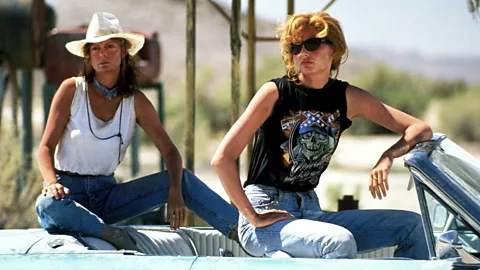 Getty Images
Getty Images"When Japanese selvedge denim replaced the ultra-baggy, hip-hop fits of the mid-to-late-90s, and then Levi's launched its Red collection of twisted, ergonomic jeans, the denim landscape changed forever," says denim designer, lecturer and historian Mohsin Sajid. "From then, denim became more elevated, appearing on catwalks and in designer brands' collections. I was working at Pringle at the time and they asked me to design a selvedge jean."
The perfect pair of jeans
Today, jeans are firmly part of the fashion mainstream; it's difficult to find a clothing brand that doesn't sell them within their collections. And most jeans now contain some synthetic stretch within the cotton mix – normally elastane, which is derived from fossil fuels and sags over time, making them less durable.
As a result, some of the shine has come off the iconic trouser and its Hollywood heyday. The UN estimates that a single pair of jeans requires 1kg of cotton, which in turn, needs about 7,500–10,000 litres of water to grow – the equivalent of 10 years' worth of drinking water for one person. As an industry, fashion produces 20% of all waste water, and the denim chemical dyeing process can be harmful to both workers and the environment.
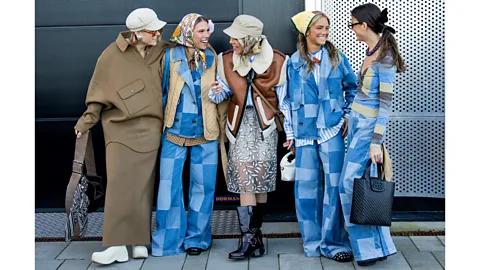 Getty Images
Getty Images"There's a reason Levi's 501 has transcended time; they're made from 100% cotton, with natural stretch," explains Professor Dilys Williams, Director of the Centre for Sustainable Fashion at London College of Fashion, UAL. "But we've become less used to wearing clothes without synthetic stretch because it's sold as more comfortable. So, it's partly about training ourselves – do we need that synthetic stretch? Or could we wear a jean in, and wait for it to shape to our bodies?"
A keen cyclist, Williams tends to get holes in her jeans. Rather than buy a new pair, she proudly patches up existing jeans to reflect her fashion identity and lifestyle. "Each pair tells a story about what has happened whilst they have been worn, the colour fades according to wear, creating a unique patina," Williams tells the BBC. "This wonderful element has, however, been sabotaged – so many jeans are pre-aged, usually using harmful chemical processes, administered by hand, in countries without strong health and safety checks. The life of the jean is sped up, its production is fast and its identity for the customer lost."
Choosing raw denim is another way to minimise the environmental impact of jeans. Also known as dry denim, it hasn't gone through pre-washing or shrinking processes in production, unlike most jeans today. The result is a dark and stiff jean that can naturally fade and soften over time.
"It can be hard to make the switch to such a dark option, but after a few months you'll never look back," says Sajid. "Imperfections like slight slubs from the spinning and weaving process make it bespoke and could develop into a great fading jean. Try to hold out on washing your jeans for the first few months and don't wash them too regularly – if you don't need to. That way, you'll develop your own wear pattern."
Sajid adds that a great pair of long-lasting jeans is a mixture of quality denim – ideally 100% regenerative cotton – using bio-based indigo (no petroleum-based dyes) in a medium 12-13oz (about 354g) weight. For added comfort and stretch, look for brands that use hemp or soft fibres like Tencel Lyocell and Tencel Modal.
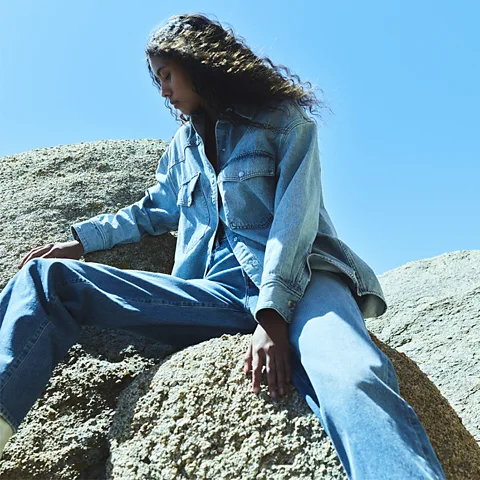 Agolde Lycra
Agolde LycraSince the early 2000s, new jeans brands have entered the market to help tackle denim's environmental impact – with no signs of innovation slowing down.
In March, Los Angeles-based luxury denim brand Agolde, owned by Citizens of Humanity, unveiled its spring collection in partnership with Lycra featuring a plant-based stretch fibre made from industrial corn within its regenerative cotton and eco-indigo dye mix.
Amy Williams, CEO of Citizens of Humanity, says that Agolde's signature silhouettes – the high-rise, wide-leg Ren and straight-leg Harper – continue to be customer favourites since the change in materials. Meanwhile, Swedish, organic cotton brand Nudie Jeans, which published its annual sustainability report this month, offers free repairs, with on-site repair shops in its stores. Last year, the brand repaired 68,342 Nudie jeans.
And ELV Denim, which made its London Fashion Week debut earlier this year, is pioneering a new luxury model based on waste. All jeans are made from upcycled materials, which would have otherwise ended up in landfill.
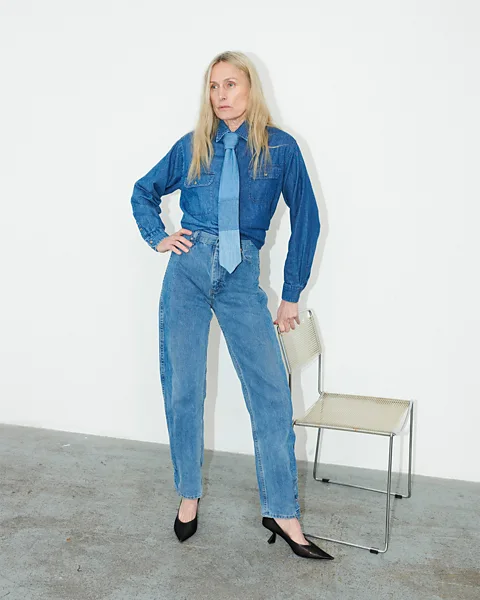 ELV
ELV"Our jeans are designed with a generous seam allowance in order to be adaptable with the wearer's body as they evolve," founder and creative director Anna Foster tells the BBC. "We even had a client who, when she was pregnant, took out the seam allowance, put in a bit of elastic to be able to wear them all through her pregnancy. After she had the baby, bit by bit she put them back."
The brand's jeans are designed to be modular, so that if one part is damaged, the brand can replace that single part as opposed to the customer having to buy a new pair. Still a young brand – ELV Denim was launched in 2018 – Foster has high hopes. "My ambition is for the whole fashion industry, not just denim. I would like to see an industry that values craft and quality and individuality of style over profit and mass production."
More like this:
• How Scandinavian dressing can make us happier
Perhaps this is the next chapter in the jeans story: individual style paired with responsibility. Like any item of clothing, jeans need not be a throwaway choice. Maybe your perfect pair is already in your wardrobe, calling to be patched-up, upcycled into something new or to be fallen in love with again – it may not be in the silhouette of the season, but it could be the one that suits you most.
That's the key to a great pair of jeans: understanding which styles make you happy. Devote some time to denim, try on different pairs, be bold and experiment, then build your denim blueprint. Add its durable quality to the mix, and a pair of jeans becomes a forever favourite – whatever the season.
Three Things to Help Heal the Planet by Ana Santi is published by Welbeck Balance.
--
If you liked this story, sign up for The Essential List newsletter – a handpicked selection of features, videos and can't-miss news, delivered to your inbox twice a week.
